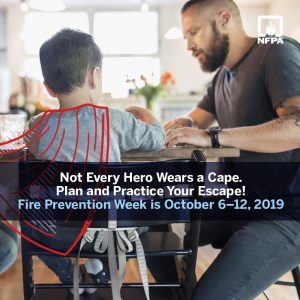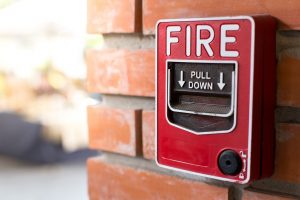Fire Prevention Week, recognized this year from Oct. 6 – 12, has been in existence for more than 90 years. VRSA is excited to promote this year’s Fire Prevention Week campaign, “Not Every Hero Wears a Cape. Plan and Practice Your Escape!” The campaign works to educate everyone about the small but important actions they can take to keep themselves and those around them safe.
NFPA statistics show that in 2017 U.S. fire departments responded to 357,000 home structure fires. These fires caused 2,630 fire deaths and 10,600 fire injuries. On average, seven people died in a fire in a home per day during 2012 to 2016.

“These numbers show that home fires continue to pose a significant threat to safety,” said Lorraine Carli, NFPA’s vice president of Outreach and Advocacy. “In a typical home fire, you may have as little as one to two minutes to escape safely from the time the smoke alarm sounds. Escape planning and practice can help you make the most of the time you have, giving everyone enough time to get out.
While the NFPA is focusing on home fires, these messages apply to virtually any location.
“Situational awareness is a skill people need to use wherever they go,” said VRSA Public Safety Specialist Gary Dillon. “No matter where you are, look for available exits. If the alarm system sounds, take it seriously and exit the building immediately.”

Home Fire Escape Planning and Practice
Home fire escape planning and drills are an essential part of fire safety. A home fire escape plan needs to be developed and practiced before a fire strikes.
Home fire escape planning should include the following:
- Drawing a map of each level of the home, showing all doors and windows
- Going to each room and pointing to the two ways out
- Making sure someone will help children, older adults, and people with disabilities wake up and get out
- Teaching children how to escape on their own in case you cannot help them
- Establishing a meeting place outside and away from the home where everyone can meet after exiting
- Having properly installed and maintained smoke alarms
Home fire escape practice should include the following:
- Pushing the smoke alarm button to start the drill
- Practicing what to do in case there is smoke: Get low and go. Get out fast.
- Practicing using different ways out and closing doors behind you as you leave
- Never going back for people, pets, or things
- Going to your outdoor meeting place
- Calling 9-1-1 or the local emergency number from a cell phone or a neighbor’s phone
For more general information about Fire Prevention Week and home escape planning, visit www.fpw.org


